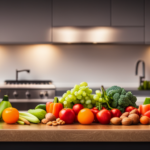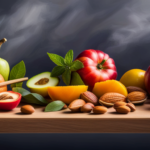Getting Started with Raw Food
Raw Food Diet How To Begin

Are you prepared to embrace a healthier way of living? If yes, why not explore the realm of raw food? Similar to a ripe and succulent fruit, a raw food diet is rich in vitality and essential nutrients that can support your overall well-being.
By consuming uncooked and unprocessed foods, you’ll be tapping into the natural goodness of fruits, vegetables, nuts, and seeds. But where do you begin on this raw food adventure? Don’t worry, I’ve got you covered.
In this article, we’ll explore the ins and outs of starting a raw food diet, from understanding the concept to stocking up on essentials and preparing delicious meals. Together, we’ll navigate this mouthwatering journey, and before you know it, you’ll be reaping the benefits of a healthier, more vibrant you.
So, let’s dive in and get started on this raw food odyssey!
Key Takeaways
- Gradually transition into a raw food lifestyle to prevent digestive issues and allow the body to adapt.
- Stock up on raw food essentials like fruits, vegetables, nuts, and seeds.
- Meal planning is essential for a successful raw food diet.
- Educate yourself on raw food nutrition to ensure long-term success.
Understanding the Concept of a Raw Food Diet
If you’re ready to embark on a life-changing journey towards vibrant health and boundless energy, then it’s time to understand the power of a raw food diet. Understanding the benefits of a raw food diet is crucial before diving into this lifestyle.
Many people believe that raw food diets are simply about eating fruits and vegetables in their natural state, but it goes beyond that. Raw food diets emphasize consuming uncooked and minimally processed foods, which retain more nutrients and enzymes than cooked foods.
Raw foods are packed with essential vitamins, minerals, and antioxidants that promote overall health and well-being. They also contain live enzymes that aid digestion and support a healthy immune system. One of the main benefits of a raw food diet is the high nutrient content.
Another benefit is weight management. Raw foods are often lower in calories than cooked foods, making them ideal for those looking to lose or maintain weight.
Now, let’s debunk some common myths surrounding raw food diets. One myth is that raw food diets lack protein. However, there are plenty of plant-based sources of protein, such as nuts, seeds, and legumes, that can easily meet your daily protein needs.
Another myth is that raw food diets are boring and restrictive. On the contrary, there are countless delicious and creative raw food recipes that can satisfy any palate.
To continue your journey towards a raw food diet, it’s important to educate yourself on raw food nutrition.
Educate Yourself on Raw Food Nutrition
To get started on your raw food journey, it’s important to familiarize yourself with the nutritional aspects of this lifestyle, just like a sailor would study the intricate maps before embarking on a voyage. Educating yourself on raw food nutrition will help you understand the benefits and debunk the myths associated with a raw food diet.
-
Raw Food Diet Benefits:
- Improved digestion: Raw foods are rich in enzymes that aid in digestion, leading to better nutrient absorption and reduced bloating.
- Increased energy levels: Raw foods are packed with vitamins, minerals, and antioxidants that provide sustained energy throughout the day.
- Weight management: A raw food diet is naturally low in calories and high in fiber, which can help with weight loss or maintenance.
-
Raw Food Diet Myths:
- Lack of protein: Raw plant-based foods can provide all the essential amino acids needed for protein synthesis.
- Nutrient deficiencies: A well-planned raw food diet can meet all your nutritional needs, including vitamins, minerals, and omega-3 fatty acids.
- Tasteless and boring: Raw food recipes can be creative and delicious, incorporating a variety of fruits, vegetables, nuts, and seeds.
By understanding the benefits and dispelling the myths, you can confidently begin your raw food journey. Start slow and gradually transition into incorporating more raw foods into your diet, allowing your body to adapt to this new way of eating.
Start Slow and Gradually Transition
Before diving headfirst into a raw food lifestyle, it’s important to ease into the transition gradually, allowing your body to adapt to the new way of eating. Starting slow has its benefits.
By gradually incorporating more raw foods into your diet, you give your digestive system time to adjust and become more efficient at breaking down raw fruits, vegetables, nuts, and seeds. This can help prevent any discomfort or digestive issues that may arise from suddenly introducing a high-fiber diet.
A gradual transition also allows you to explore different raw food recipes and find what works best for you. You can experiment with different flavors, textures, and combinations, ensuring that you enjoy your meals and don’t feel deprived. This approach increases the likelihood of long-term success and adherence to a raw food diet.
Additionally, starting slow gives you time to educate yourself on proper nutrition and meal planning for a raw food lifestyle. Understanding the principles of balanced raw food nutrition will help you create a well-rounded and nutrient-dense diet, ensuring you meet your body’s needs.
As you gradually transition to a raw food lifestyle, it’s important to stock up on raw food essentials to make the process easier and more convenient.
Stocking Up on Raw Food Essentials
When embarking on a raw food journey, it’s crucial to ensure your pantry is filled with all the essential ingredients that will make your culinary adventures exciting and delicious. Raw food shopping can be a bit overwhelming at first, but with a well-stocked raw food pantry, you’ll be able to create a wide variety of nutritious and satisfying meals. To help you get started, here is a handy table to guide you on what to stock up on:
| Fruits | Vegetables |
|---|---|
| Apples | Spinach |
| Oranges | Carrots |
| Bananas | Cucumbers |
| Berries | Bell Peppers |
These are just a few examples, but feel free to explore other options and choose fruits and vegetables that you enjoy. Additionally, it’s important to have some staple items such as nuts, seeds, and dried fruits for added texture and flavor in your raw food dishes. Once you have your raw food pantry stocked up, you’ll be ready to start planning and preparing raw food meals that are both nutritious and delicious.
Now, let’s move on to the next section where we will discuss the importance of planning and preparing raw food meals.
Planning and Preparing Raw Food Meals
Now that you’ve stocked up your raw food pantry with all the essentials, get ready to dive into the exciting world of planning and preparing delicious, nutritious meals that’ll leave you craving for more.
Meal planning is an essential part of a successful raw food diet. It helps you stay organized, ensures you have all the necessary ingredients on hand, and allows you to make the most out of your raw food journey.
When it comes to meal planning, it’s important to consider the kitchen equipment you’ll need. Investing in a good quality blender is a must for creating smoothies, sauces, and dressings. A food processor is another handy tool for chopping, slicing, and shredding fruits and vegetables. Additionally, having a dehydrator can help you create tasty snacks like kale chips or fruit leathers.
To make meal planning easier, start by creating a weekly menu. This’ll give you a clear idea of what meals you’ll be having each day and what ingredients you’ll need to have on hand. Make sure to include a variety of fruits, vegetables, nuts, and seeds to ensure you’re getting a good balance of nutrients.
Transitioning to a raw food diet may present some challenges and obstacles, but with proper planning and preparation, you can overcome them and thrive on this exciting culinary journey.
Overcoming Challenges and Obstacles
To truly thrive on this exciting culinary journey, you’ll need to tackle and conquer the challenges and obstacles that come your way. Overcoming mindset barriers is crucial when transitioning to a raw food diet. It’s common to feel overwhelmed or doubt your ability to stick to this lifestyle change. Remember that it’s a process, and with time and practice, it’ll become easier.
-
Stay positive and motivated: Surround yourself with supportive people and engage in activities that inspire you. This’ll help you maintain a positive mindset and stay motivated on your raw food journey.
-
Plan ahead: One of the biggest challenges is maintaining your social life while following a raw food diet. Plan ahead for social gatherings by bringing your own raw food dishes or suggesting raw food-friendly restaurants. This way, you can enjoy the company of others while staying true to your dietary choices.
-
Educate yourself: Knowledge is power. Learn about the benefits of a raw food diet and the science behind it. This’ll help you overcome any doubts or criticisms from others and reinforce your commitment to this lifestyle.
-
Find alternatives: Cravings for cooked or processed foods may arise. Experiment with raw food recipes that mimic the flavors and textures you enjoy. This’ll help you satisfy cravings and stay on track.
By overcoming these challenges and obstacles, you’ll be able to listen to your body and make adjustments as needed in your raw food journey. Remember, it’s all about finding what works best for you and nourishing your body in a way that feels good.
Listening to Your Body and Making Adjustments
Embrace the intuitive whispers of your body, allowing it to be your compass as you navigate your unique culinary journey towards nourishment and fulfillment. When embarking on a raw food diet, it’s important to listen to your body and make adjustments along the way. Your body is constantly sending signals and feedback about what it needs and what works best for you. By paying attention to these cues, you can fine-tune your raw food diet to suit your individual needs.
One way to listen to your body is by keeping a food journal. This can help you identify patterns and make connections between what you eat and how you feel. For example, you may notice that certain foods make you feel energized and vibrant, while others leave you feeling sluggish or bloated. By making adjustments based on these observations, you can optimize your raw food diet to support your overall well-being.
Incorporating a 3 column and 5 row table can help you track your food choices, symptoms, and feelings. Here’s an example:
| Food Choice | Symptoms | Feelings |
|---|---|---|
| Kale salad | Increased energy, improved digestion | Happy, satisfied |
| Banana smoothie | Bloating, stomachache | Tired, uncomfortable |
| Raw nuts | Sustained energy, satisfied hunger | Calm, focused |
By using this table, you can identify trends and make adjustments accordingly. For instance, if you notice that certain foods consistently cause discomfort, you can choose alternatives that provide similar benefits without the negative effects.
Listening to your body and making adjustments is essential for long-term success on a raw food diet. It allows you to fine-tune your choices and create a sustainable and enjoyable eating plan. By paying attention to how different foods make you feel and making adjustments accordingly, you can optimize your health and well-being.
As you continue on your raw food journey, staying motivated and inspired is crucial. [Transition sentence to next section about staying motivated and inspired.]
Staying Motivated and Inspired
When it comes to staying motivated and inspired on a raw food diet, I find that success stories from others who’ve achieved their health goals can be incredibly motivating. Hearing about their transformations and the positive impact that raw food has had on their lives reminds me why I started this journey in the first place.
Additionally, exploring new raw food recipes and techniques keeps the diet exciting and helps me avoid getting bored with my meals. Trying out different flavors and textures keeps things interesting and helps me stay committed to the raw food lifestyle.
Finding inspiration from success stories and community support
Seeking motivation from real-life success stories and the unwavering support of a like-minded community can ignite a fire within, propelling you towards the transformative journey of a raw food diet. Hearing about others who’ve achieved their health goals through raw food can be incredibly inspiring and give you the confidence to push forward.
The raw food community provides a space for sharing experiences, asking questions, and receiving encouragement. Being a part of this supportive network can help you stay motivated and accountable to your own goals. It’s amazing how much inspiration can be found in the stories of others who’ve overcome challenges and achieved success on their raw food journey.
By tapping into this collective wisdom and support, you can stay motivated and inspired to continue on your own path of raw food exploration and growth.
Now, let’s dive into the exciting world of exploring new raw food recipes and techniques to keep the diet exciting.
Exploring new raw food recipes and techniques to keep the diet exciting
After finding inspiration from success stories and receiving support from the raw food community, it’s time to explore new raw food recipes and techniques to keep the diet exciting. Incorporating new raw food ingredients and getting creative with the presentation can make a significant difference in the overall enjoyment of the raw food lifestyle. To provide a visual representation of ideas, I have created a table below showcasing three exciting and delicious recipes that utilize unique raw food ingredients and innovative presentation techniques.
| Recipe Name | Main Ingredients | Presentation Technique |
|---|---|---|
| Zucchini Noodles with Avocado Pesto | Zucchini, Avocado, Basil, Lemon | Spiralized zucchini noodles topped with creamy avocado pesto |
| Raw Vegan Sushi Rolls | Nori Sheets, Cauliflower Rice, Avocado, Carrot, Cucumber | Traditional sushi rolling technique using raw, plant-based ingredients |
| Raw Chocolate Mousse | Avocado, Cacao Powder, Maple Syrup, Vanilla Extract | Smooth and velvety chocolate mousse made from avocado and cacao powder |
By incorporating these new recipes and techniques, the raw food diet can remain exciting and enjoyable. However, it’s also important to consider other aspects of a healthy lifestyle, such as incorporating exercise and self-care.
Incorporating Exercise and Self-Care into Your Raw Food Lifestyle
To truly thrive on a raw food diet, it’s essential to infuse your daily routine with self-care practices and regular exercise, giving your body the love and attention it deserves. Incorporating exercise routines and self-care practices into your raw food lifestyle can provide numerous benefits for both your physical and mental well-being.
When it comes to exercise, finding routines that work for you is key. Whether it’s going for a brisk walk, practicing yoga, or engaging in high-intensity interval training, the goal is to get your body moving and your heart rate up. Regular exercise not only helps to strengthen your muscles and improve your cardiovascular health, but it also boosts your mood and reduces stress.
Self-care practices are equally important. Taking time for yourself each day to relax, unwind, and pamper your body is crucial for maintaining a healthy lifestyle. This can include activities such as meditation, taking a warm bath, practicing deep breathing exercises, or indulging in a soothing massage. Prioritizing self-care allows you to recharge and rejuvenate, ensuring you have the energy and motivation to stick to your raw food diet.
By incorporating exercise and self-care practices into your raw food lifestyle, you’re not only nourishing your body with nutritious foods but also taking care of your overall well-being. Celebrating your progress and enjoying the benefits of this holistic approach will only further motivate you in your journey towards optimal health and vitality.
Celebrating Your Progress and Enjoying the Benefits
After incorporating exercise and self-care into my raw food lifestyle, I’ve noticed significant improvements in my overall well-being. Not only do I feel energized and refreshed, but I’ve also experienced a boost in my mood and mental clarity. It’s amazing how taking care of my body has had such a positive impact on my mind.
Now that I’ve made progress on my raw food journey, it’s important to take a moment to celebrate my achievements and enjoy the benefits of this lifestyle. Here are a few ways I can celebrate my milestones and continue to reap the rewards of a raw food diet:
-
Reflect and appreciate: Take some time to reflect on how far I’ve come and appreciate the positive changes I’ve experienced. Keeping a journal or creating a gratitude list can help me acknowledge and celebrate my progress.
-
Treat myself: Indulge in some raw food treats or create a special raw food meal to celebrate reaching a milestone. Trying out new recipes or visiting a raw food restaurant can be a fun way to reward myself for my dedication.
-
Share with others: Spread the joy and benefits of a raw food diet by sharing my experiences and recipes with friends and family. Hosting a raw food potluck or organizing a cooking class can be a great way to celebrate while also inspiring others to embrace this healthy lifestyle.
By celebrating my progress and enjoying the benefits of a raw food diet, I can stay motivated and continue on this journey towards optimal health and well-being.
Frequently Asked Questions
Can I still eat cooked foods occasionally while following a raw food diet?
Yes, you can still enjoy cooked foods occasionally while following a raw food diet. It’s all about finding a balance that works for you. Incorporating cooked food alternatives can help satisfy cravings and add variety to your meals. However, it’s important to remember that the majority of your diet should consist of raw, unprocessed foods to maximize their nutritional benefits. Experiment with different cooking methods like steaming or lightly sautéing to retain more nutrients.
What are the potential health risks associated with a raw food diet?
When it comes to a raw food diet, it’s important to be aware of the potential risks and health concerns. While this diet can offer many benefits, such as increased nutrient intake and weight loss, there are some things to consider.
One potential risk is the increased risk of foodborne illnesses, as raw foods are not cooked and can harbor harmful bacteria. Additionally, a raw food diet may be deficient in certain nutrients like vitamin B12 and iron.
It’s crucial to consult with a healthcare professional before starting this diet to ensure you’re meeting your nutritional needs.
How can I ensure I am getting all the necessary nutrients on a raw food diet?
Ensuring nutrient balance on a raw food diet requires careful meal planning. It’s important to include a variety of fruits, vegetables, nuts, seeds, and sprouted grains to meet your nutritional needs.
Incorporating foods rich in protein, such as legumes and leafy greens, can help ensure you’re getting enough of this essential nutrient.
Additionally, it’s recommended to supplement with vitamin B12, as it’s mainly found in animal products.
Consulting with a registered dietitian can provide personalized guidance for a well-rounded raw food diet.
Are there any specific kitchen tools or equipment that are essential for preparing raw food meals?
When it comes to preparing raw food meals, there are a few essential kitchen tools that can make the process much easier and more efficient. A good quality blender is a must-have for creating smoothies, sauces, and dressings.
A food processor can be used for chopping, shredding, and mixing ingredients.
Additionally, a high-speed juicer is great for extracting fresh juices from fruits and vegetables.
These tools will help you whip up delicious raw food meals in no time.
Can I eat out at restaurants while following a raw food diet, and if so, what are some tips for navigating the menu?
Yes, you can eat out at restaurants while following a raw food diet. When dining at social events or non-raw restaurants, it’s important to navigate the menu wisely.
Look for options like salads, vegetable dishes, and fresh fruit. You can also ask the server if they can accommodate your raw food preferences.
It’s helpful to plan ahead and research restaurants that offer raw food options. Remember to communicate your dietary needs and be open to making modifications to ensure you stay true to your raw food lifestyle.
Can Shatavari Be Included in a Raw Food Diet?
Shatavari can be included in a raw food diet by adding the dried powder to smoothies, juices, or energy balls. You can also sprinkle it over salads or mix it into raw desserts. The adaptogen properties of shatavari can complement the benefits of a raw food diet. This is how to take shatavari in raw food world.
Conclusion
In conclusion, embarking on a raw food diet can be a transformative journey that requires dedication and a willingness to explore new tastes and textures.
By understanding the concept of raw food nutrition and gradually transitioning into this lifestyle, you can reap the numerous health benefits that come with it.
It’s important to stock up on raw food essentials, plan and prepare your meals, listen to your body’s needs, and stay motivated throughout your journey.
Remember to incorporate exercise and self-care, celebrate your progress, and enjoy the incredible benefits of a raw food lifestyle.
With her ability to convey complex concepts in a clear and accessible manner, Belinda ensures that readers of all backgrounds can grasp the benefits and techniques of raw food. She excels at breaking down scientific information into digestible pieces, allowing readers to understand the impact of raw food on their bodies and encouraging them to make informed choices about their diet.
One of Belinda’s notable contributions to rachaelsrawfood.com is her collection of mouthwatering recipes. She delights in experimenting with various combinations of raw ingredients, exploring innovative ways to create delicious and nutritious meals. Belinda’s recipes showcase the incredible flavors and textures of raw food and emphasize its versatility, dispelling any misconception that a raw food diet is limited or monotonous.
In addition to her writing responsibilities, Belinda actively engages with the raw food community, attending workshops, seminars, and conferences to expand her knowledge and network. She enjoys connecting with like-minded individuals, exchanging ideas, and staying up to date with the latest trends and advancements in the field of raw food nutrition.
Getting Started with Raw Food
Does Raw Food Make Dogs Constipated? Find Out Here
Observe the signs of constipation in dogs on a raw food diet; discover how to ensure their digestive health. What solutions exist?
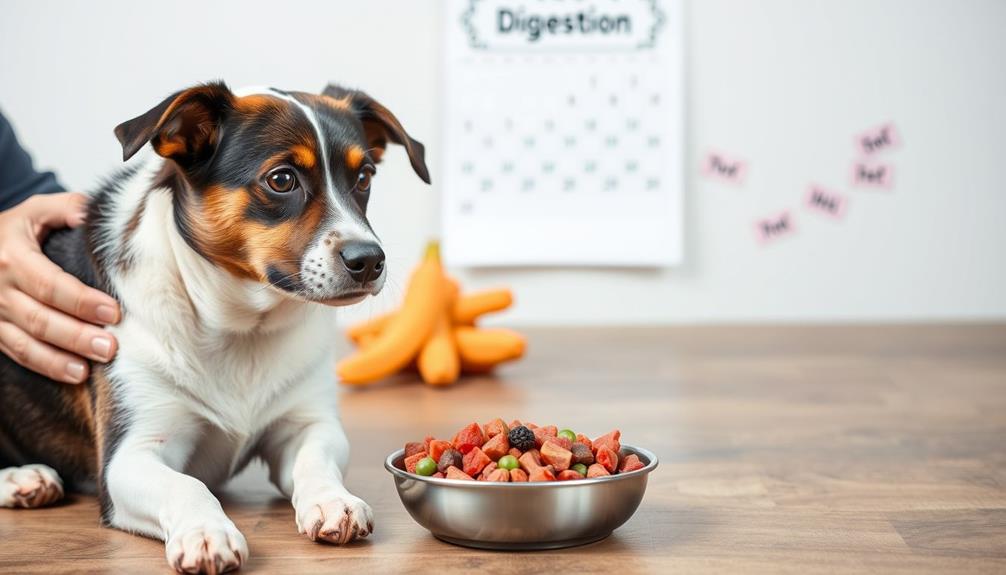
Feeding your dog a raw food diet can indeed cause constipation if it isn't balanced right. Excessive bone content might lead to hard stools, while not including enough fiber from fruits and vegetables can worsen the issue. Dehydration is also common with raw diets, contributing to stool hardness. If you notice signs like straining to defecate or rock-hard stools, it's important to adjust the diet. Adding fiber-rich foods like pumpkin and keeping your dog hydrated are key. There's more you can do to guarantee a healthy digestion for your dog, so keep exploring options for their diet.
Key Takeaways
- Raw diets can lead to constipation due to excessive bone content resulting in hard stools.
- Insufficient fiber from a lack of fruits and vegetables can exacerbate digestive issues.
- Dehydration is common in raw diets, which contributes to stool hardness.
- Rapid transitions to a raw diet without gradual adjustments may disrupt a dog's digestion.
- Regular monitoring of stool consistency and dietary balance is essential for preventing constipation.
Understanding Dog Constipation
Constipation in dogs can be a concerning issue for pet owners, and it's important to recognize the signs early. You might notice that your dog hasn't had a bowel movement for over 24 hours, is straining while trying to defecate, or producing rock-hard stools. These symptoms indicate that your dog's digestive tract needs attention.
Diet plays an essential role in your dog's bowel health, and understanding proper hamster care can help you appreciate the importance of nutrition in pet health. If your dog is on a raw diet, insufficient fiber and excessive bone content can contribute to constipation. It's crucial to provide enough fiber to help your dog maintain regular bowel movements. Foods like pumpkin and leafy greens can be excellent additions to their diet.
Additionally, keep an eye on your dog's hydration and make sure they get plenty of exercise. Both of these factors are significant for promoting healthy digestion and preventing constipation.
If you're concerned about your dog's condition, consider adjusting their diet by reducing bone content and incorporating fiber-rich foods. By taking these steps, you can help your dog overcome constipation and support their overall health.
Causes of Constipation in Raw Diets
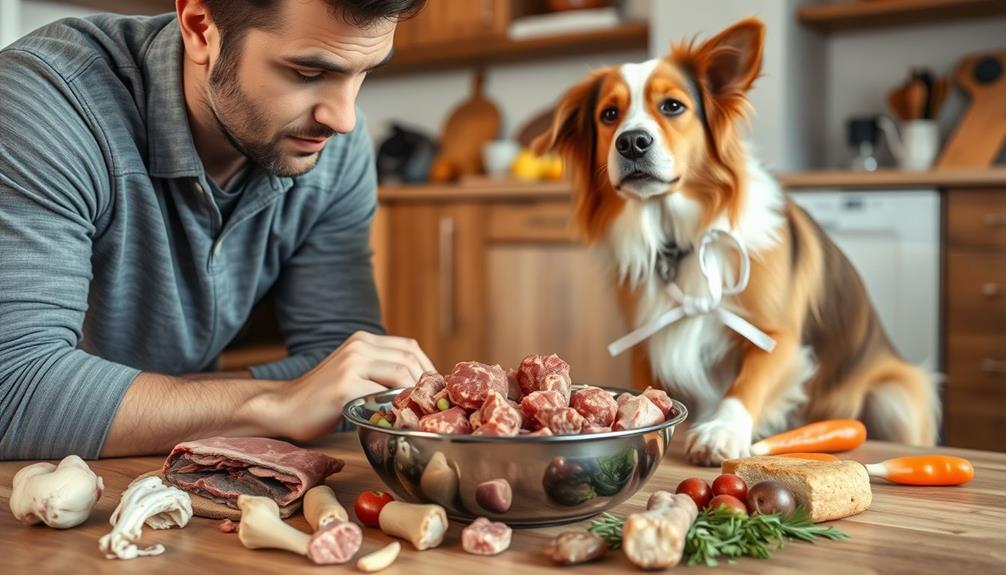
A raw diet can sometimes lead to constipation in dogs, primarily due to excessive bone content. When the diet consists of too many bones, it can result in hard stools that hinder regular bowel movements.
Additionally, insufficient fiber intake from a lack of fruits and vegetables can exacerbate the problem. It's essential to incorporate fiber-rich foods like pumpkin and leafy greens to support healthy digestion, as recommended in gout nutrition guidelines.
Dehydration also plays a significant role in constipation. Since raw diets often contain less moisture than processed foods, your dog may not be drinking enough water, further contributing to hard stools.
Stress, changes in routine, or dietary imbalances can influence gut motility, leading to irregular bowel movements as well.
Moreover, if you shift your pet to a raw diet too quickly without a gradual introduction of new foods, it can disrupt their digestive system. This sudden change may result in constipation or other gastrointestinal issues.
To prevent these causes of constipation, verify that your dog's raw diet is balanced and includes sufficient fiber and hydration. This way, you can help maintain your dog's digestive health.
Signs and Symptoms to Observe

Recognizing the signs and symptoms of constipation in your dog is essential for timely intervention. Pay close attention to any lack of stool for over 24 hours, as this can be a clear indication that your dog is experiencing constipation.
If you notice your dog is straining during defecation, it's vital to take action. Straining often accompanies hard stools that resemble pebbles, signaling that your dog may be in discomfort. Additionally, providing your dog with healthy snacks can promote better digestion and overall health, potentially mitigating constipation issues.
Behavioral changes can also be significant. If your dog seems reluctant to move, avoids activities they usually enjoy, or shows signs of discomfort while attempting to relieve themselves, these may be warning signs of constipation.
It's important to monitor stool consistency regularly. Hard stools can lead to further complications, so keeping an eye on your dog's bathroom habits is key.
Dietary Adjustments for Relief
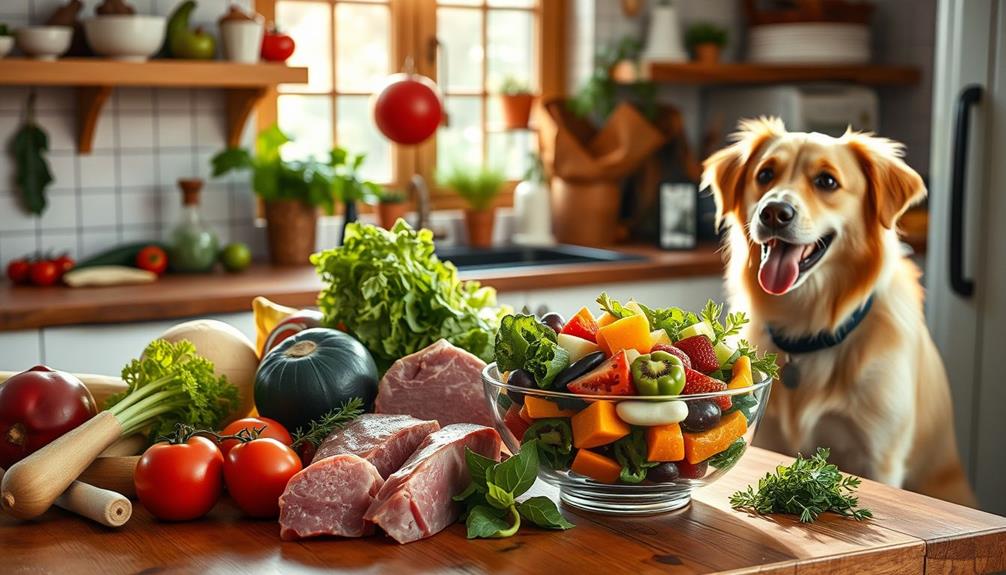
Making dietary adjustments can greatly help alleviate your dog's constipation. Start by reducing the frequency of raw meaty bones in their diet, as these can lead to drier, harder stools.
Instead, focus on incorporating extra fruits and vegetables, like pumpkin or leafy greens, which provide essential fiber that aids in regulating bowel movements. Additionally, guaranteeing proper hydration is vital; consider how air quality considerations can parallel maintaining your dog's overall health, including digestive wellness.
Feeding a balanced raw diet consisting of 80% muscle meat, 10% bone, and 10% offal guarantees your dog gets adequate moisture and nutrients, promoting healthy digestion.
Pureed pumpkin or canned unsweetened pumpkin can be particularly effective, thanks to its high fiber content, making it easier for your dog to defecate without straining.
Don't forget about hydration! Make sure your dog has access to fresh water or bone broth, as regular hydration is essential for maintaining stool consistency and preventing constipation.
By making these dietary adjustments, you'll create a more balanced raw food experience that supports your dog's digestive health and helps alleviate constipation.
Supplement Options for Digestive Health
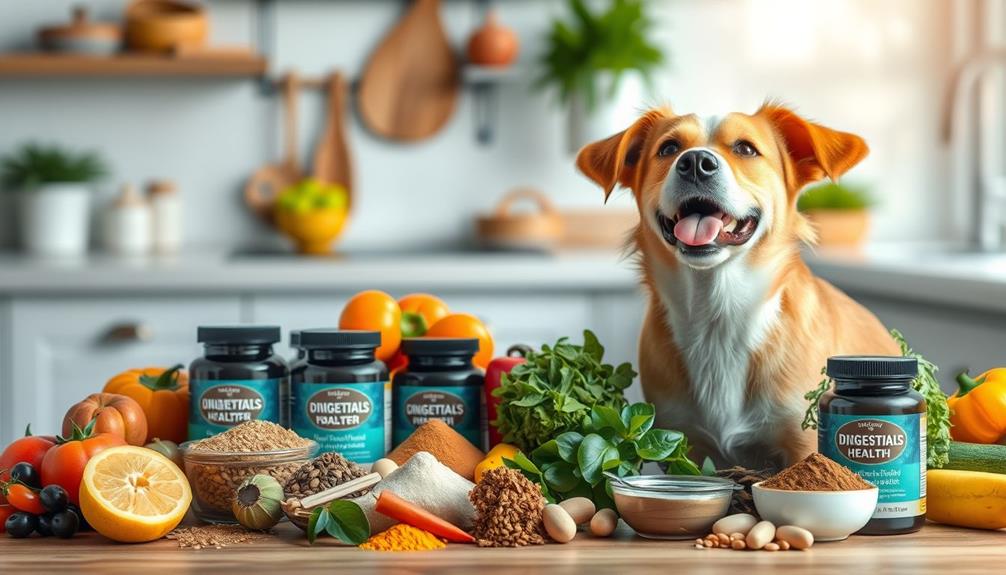
How can you enhance your dog's digestive health while minimizing constipation? Exploring effective supplement options can make a significant difference. Here are some to evaluate:
- Probiotics: These promote a diverse gut microbiome, which is essential for good digestion and can help mitigate issues such as gastrointestinal issues.
- Digestive enzymes: They help break down raw proteins and fats, improving nutrient absorption.
- Slippery elm: This natural remedy soothes the gastrointestinal tract and creates a protective mucous lining. A dosage of ¼ teaspoon per 10 lbs of body weight is recommended.
- Leafy greens: Incorporating fiber-rich foods like kale or spinach can regulate bowel movements, alleviating constipation.
- Omega-3 oil: Regular supplementation with this healthy oil supports overall digestive health and improves stool consistency.
When to Consult a Veterinarian
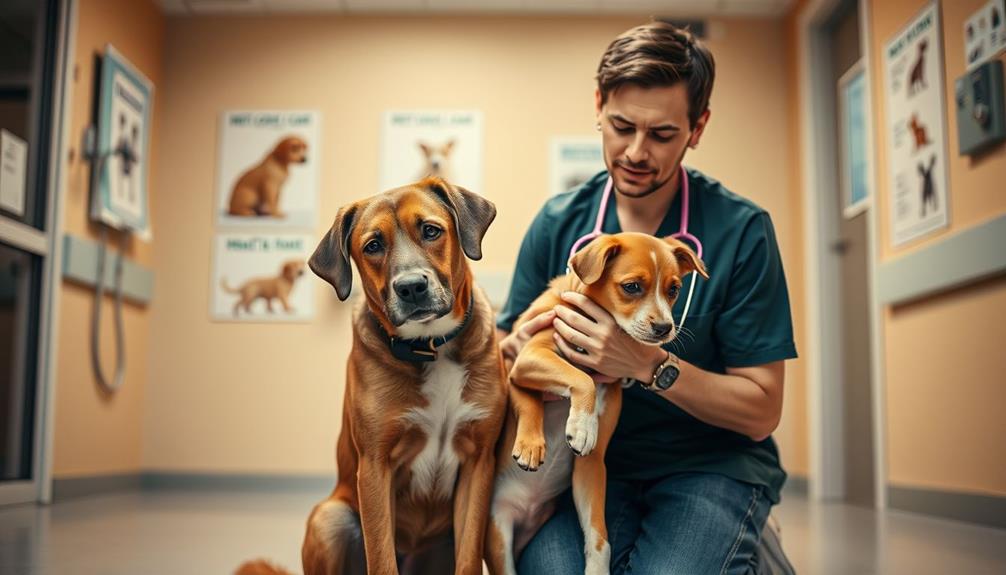
If your dog hasn't had a bowel movement in over 24 hours, it's time to consult a veterinarian.
It's important to keep an eye on your dog's overall behavior and health, as changes can indicate underlying issues that may require immediate attention.
Look out for persistent straining, discomfort, or any behavioral changes that indicate pain.
Addressing these signs early can help prevent more serious health issues down the line.
Additionally, emotional and psychological support available for families can be beneficial during such stressful times.
Persistent Lack of Stool
When your dog goes more than 24 hours without a stool, it's time to consult a veterinarian to rule out any serious health issues. A persistent lack of stool can indicate underlying problems that need addressing.
Here are some signs to watch for:
- Decreased energy levels or reluctance to move
- Hard, rock-like stools that signal constipation
- Straining to defecate with little or no output
- Signs of pain during attempts to relieve themselves
- Changes in appetite or behavior, indicating discomfort
If your dog's raw food diet lacks fiber, it could cause constipation, leading to infrequent dogs' bowel movements. Adding vegetables such as spinach, carrots, and sweet potatoes to their diet can help increase the fiber content and improve their digestion. It is important to consult with a veterinarian before switching to raw dog food, as they can provide guidance on the best diet for your dog’s specific needs. In some cases, adding a fiber supplement may also be necessary to ensure your dog’s digestive health.
Creating a personal budget for your pet's dietary needs can guarantee they receive the right nutrients. Loose stools can also disrupt gut health, making it essential to maintain a balanced diet.
If you notice any of these symptoms, don't hesitate to seek veterinary advice. Early intervention is key to identifying and treating the root cause of your dog's persistent lack of stool.
Delaying could complicate the situation, so it's best to act promptly. Remember, your dog's well-being depends on your vigilance in recognizing these signs!
Straining and Discomfort Signs
Straining to defecate can be a clear sign that your dog is experiencing constipation, and it's important to recognize this symptom early.Breast cancer symptoms in dogs can sometimes mimic signs of discomfort, so it's vital to differentiate between the two. If you notice your dog straining excessively or having difficulty passing stool, it's necessary to consult a veterinarian, especially if this persists. Signs of discomfort, like whining or trembling while attempting to defecate, should prompt an immediate visit to the vet.
A lack of bowel movements for more than 24 hours is a significant indicator of constipation and requires professional evaluation to rule out any underlying issues. Additionally, if your dog produces rock-hard stool consistently, this often signifies constipation, and you should seek veterinary advice.
Keep an eye on any changes in your dog's behavior; decreased activity levels or reluctance to move may also signal discomfort related to being constipated.
Addressing these signs of discomfort promptly can help prevent more serious health problems down the line. Remember, when in doubt about your dog's bowel habits or overall well-being, don't hesitate to reach out for a veterinary consultation. Your dog's health and comfort should always come first.
Behavioral Changes and Pain
Recognizing behavioral changes in your dog can provide important clues about their health, especially regarding constipation.
Similar to individuals with BPD dynamics in relationships, dogs may exhibit changes in behavior when experiencing discomfort or pain. If your dog exhibits any of the following signs, it's time to reflect on a vet consultation:
- Reluctance to move or play
- Straining and difficulty when trying to defecate
- Whining or trembling during attempts to have a bowel movement
- Rock-hard stools that are difficult to pass
- An absence of bowel movements for more than 24 hours
These signs of pain and discomfort can indicate that your dog needs immediate attention.
Straining to defecate is a clear indicator of constipation, and if your pet struggles for over a day, it may suggest a more serious underlying issue. Obvious signs of distress during defecation, such as whining, should never be ignored.
If you notice any of these behavioral changes, don't hesitate to consult your vet.
Early intervention can prevent complications and guarantee your dog's digestive health is maintained.
Frequently Asked Questions
Is It Normal for Dogs to Poop Less on a Raw Diet?
It's normal for dogs to poop less on a raw diet. You'll notice smaller, firmer stools due to higher digestibility. Just keep an eye out for any signs of constipation or distress in your dog.
How Do You Soften a Dog's Poop on a Raw Diet?
Did you know that 60% of dog owners notice firmer stools on a raw diet? To soften your dog's poop, balance their meals, add fiber, guarantee hydration, and encourage daily exercise for ideal digestive health.
What Foods Cause Dogs to Be Constipated?
Certain foods can cause constipation in dogs. High bone content, low-fiber diets, dry kibble, excessive lean meats, and non-digestible items like toys can all contribute to hard stools. Guarantee a balanced diet to prevent this.
How Long Does It Take for a Dog to Digest Raw Food and Poop?
It usually takes your dog 12 to 24 hours to digest raw food, depending on their age and size. You might notice smaller, less frequent stools due to improved nutrient absorption from the diet.
Conclusion
To sum up, while a raw food diet can be beneficial for many dogs, it can also lead to constipation if not balanced properly. Keep an eye on your pup's signs and symptoms, and make dietary adjustments as needed. If the issue persists, don't hesitate to consult your veterinarian, who can help you navigate this digestive maze. Remember, with the right approach, you can keep your dog's tummy happier than a kid in a candy store!
With her ability to convey complex concepts in a clear and accessible manner, Belinda ensures that readers of all backgrounds can grasp the benefits and techniques of raw food. She excels at breaking down scientific information into digestible pieces, allowing readers to understand the impact of raw food on their bodies and encouraging them to make informed choices about their diet.
One of Belinda’s notable contributions to rachaelsrawfood.com is her collection of mouthwatering recipes. She delights in experimenting with various combinations of raw ingredients, exploring innovative ways to create delicious and nutritious meals. Belinda’s recipes showcase the incredible flavors and textures of raw food and emphasize its versatility, dispelling any misconception that a raw food diet is limited or monotonous.
In addition to her writing responsibilities, Belinda actively engages with the raw food community, attending workshops, seminars, and conferences to expand her knowledge and network. She enjoys connecting with like-minded individuals, exchanging ideas, and staying up to date with the latest trends and advancements in the field of raw food nutrition.
Getting Started with Raw Food
Why Is Raw Food Bad for Cats? Essential Information
Overlooking the dangers of raw food diets for cats can lead to serious health risks; discover what you need to know for your feline’s safety.
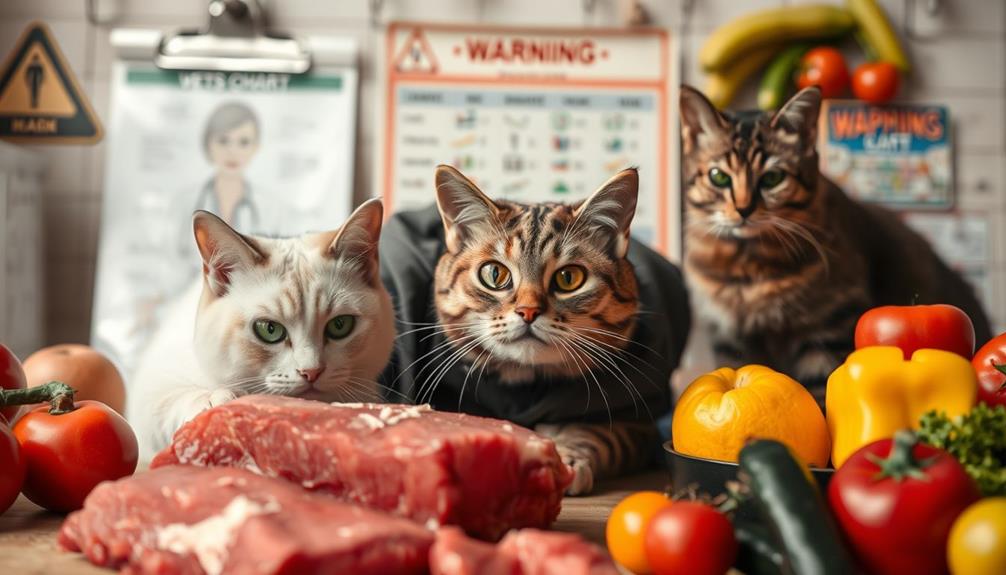
Feeding your cat a raw food diet can be risky due to harmful bacteria like Salmonella and E. coli, which can cause severe gastrointestinal issues such as vomiting and diarrhea. About 25% of raw pet food samples have tested positive for these pathogens. Additionally, raw diets often lack essential nutrients like taurine, which can lead to serious health problems over time. Contamination during preparation increases health risks not just for your cat but for humans as well. Safety practices are vital if you decide to go this route, but there are safer, balanced alternatives that might better meet your cat's needs.
Key Takeaways
- Raw food diets can expose cats to harmful pathogens like Salmonella and E. coli, posing health risks to both pets and humans.
- Nutritional deficiencies are common in raw diets, lacking essential nutrients necessary for a cat's overall health and development.
- Improper preparation and handling of raw food increase the risk of contamination, leading to severe gastrointestinal issues in cats.
- Cats can be asymptomatic carriers of pathogens, increasing the risk of transmitting infections to humans through raw food.
- High-quality commercial cat foods offer balanced nutrition and are safer alternatives, minimizing health risks associated with raw diets.
Health Risks of Raw Food
When considering a raw food diet for your cat, it's vital to understand the health risks involved. Raw food diets can carry significant contamination risks with harmful pathogens such as Salmonella and E. coli. Studies indicate that nearly 25% of raw pet food samples test positive for these bacteria. The CDC estimates that there are about 1.2 million annual cases of foodborne salmonellosis in the U.S., and your cat could act as an asymptomatic carrier, increasing the risk of human exposure.
Additionally, just as in financial planning for elderly care, understanding the long-term impact of dietary choices is important for maintaining overall health and well-being.
Moreover, Listeria monocytogenes, another pathogen found in raw diets, poses serious dangers, especially for vulnerable populations like pregnant women and newborns. Cats fed raw diets may experience gastrointestinal issues such as vomiting and diarrhea, which can lead to severe health consequences for both them and their human caregivers.
Veterinary organizations like the CDC and AVMA strongly advise against raw diets due to these health risks. They emphasize the importance of safe handling practices to minimize contamination, but even with precautions, the dangers of raw pet food remain significant.
Ultimately, you must weigh these risks carefully when considering your cat's diet.
Nutritional Concerns
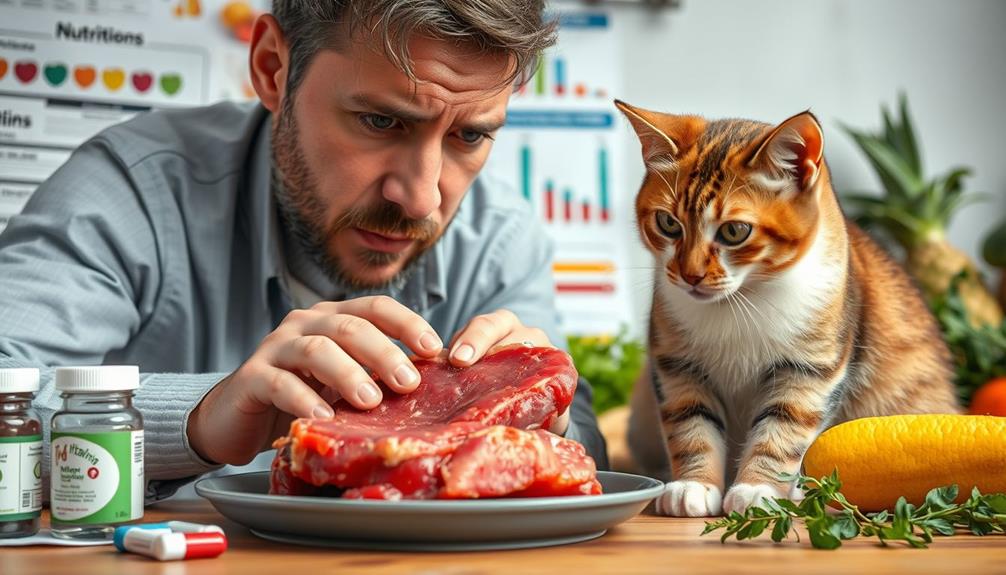
Cats thrive on balanced nutrition, but raw food diets often fall short in providing essential nutrients. Many raw food diets lack essential components like taurine, vitamins A, D, and E, which are critical for your cat's health. Without these essential nutrients, your feline friend could face serious nutritional deficiencies that lead to health issues over time.
Furthermore, it's important to understand the implications of dietary choices on overall health and wellness, as proper budgeting for pet care guarantees your cat receives the best nutrition possible.
Homemade raw diets frequently miss the mark on meeting complete and balanced nutritional requirements. This oversight can result in calcium imbalances, affecting bone health and overall development, particularly in growing cats. In adult cats, these imbalances can also lead to significant health concerns.
Additionally, without veterinary guidance, feeding your cat a raw food diet can be risky. Only a small percentage of analyzed homemade raw diets have been found to be complete and balanced. The potential for harmful bacteria in raw diets can further complicate nutritional adequacy, as it may contribute to nutrient loss.
To guarantee your cat receives the balanced diet they need, consult with a veterinarian before making any changes to their diet, especially if you're considering raw food options.
Pathogen Contamination
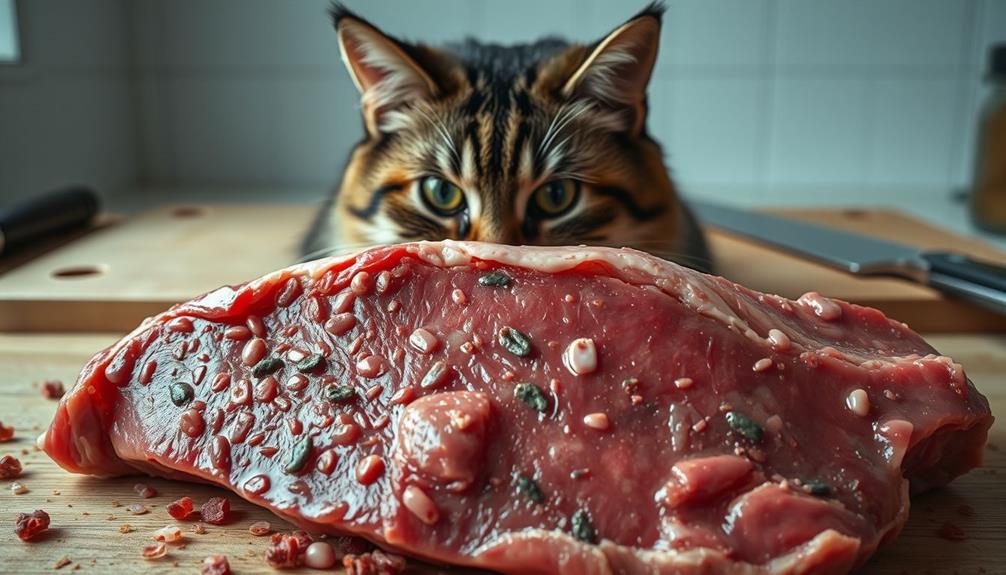
Feeding your cat a raw food diet can open the door to serious health risks, particularly due to pathogen contamination. Studies show that nearly 25% of raw cat food samples are contaminated with harmful bacteria, including Salmonella and Listeria.
These pathogens can pose significant risks not only to your cat but also to your household. Pets with emotional dysregulation, such as those with BPD dynamics in relationships, may also exhibit increased anxiety, making them more vulnerable to health issues.
Salmonella, for instance, causes around 1.2 million human infections each year, with cats often acting as asymptomatic carriers, increasing the chance of transmission to humans.
Listeria monocytogenes, another common threat in raw diets, leads to severe foodborne illnesses, contributing to approximately 1,600 cases and 260 deaths annually in the US. The risks escalate, especially in households with young children or immunocompromised individuals, as they're more vulnerable to these pathogens.
Improper preparation and handling raw food can exacerbate the risks of contamination, making it critical to understand the serious implications of a raw diet.
While your cat may enjoy the taste, the potential health hazards from contaminated raw cat food can lead to dire consequences for both your pet and your family.
Safe Handling Practices
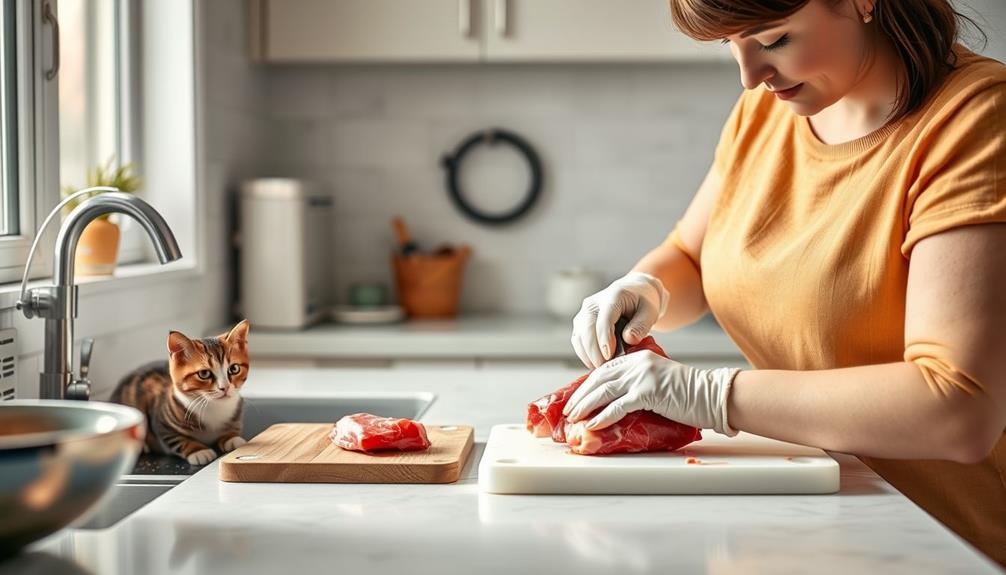
Practicing safe handling techniques is vital to minimize the risks associated with feeding your cat a raw food diet. As a pet parent, you need to be vigilant about harmful bacteria like Salmonella and Listeria that can thrive in raw cat food.
Regularly monitoring your cat's health for any signs of illness can also be beneficial, as certain dietary choices may impact their well-being, including ultimate hamster care. Always wash your hands thoroughly with soap and water after handling any raw food. This simple step helps prevent the spread of these pathogens.
To guarantee a safe environment, clean and disinfect all surfaces, utensils, and feeding dishes that come into contact with raw food. Remember to store raw cat food in the freezer until you're ready to use it, and thaw it safely in the refrigerator or microwave. This prevents bacterial growth and keeps your cat's nutritional needs in check.
Keep raw cat food separate from human food items during storage and preparation to avoid cross-contamination. It's also important to avoid rinsing raw meat before preparation, as this can cause splashing and spread bacteria to surrounding surfaces and utensils.
Alternatives to Raw Diets
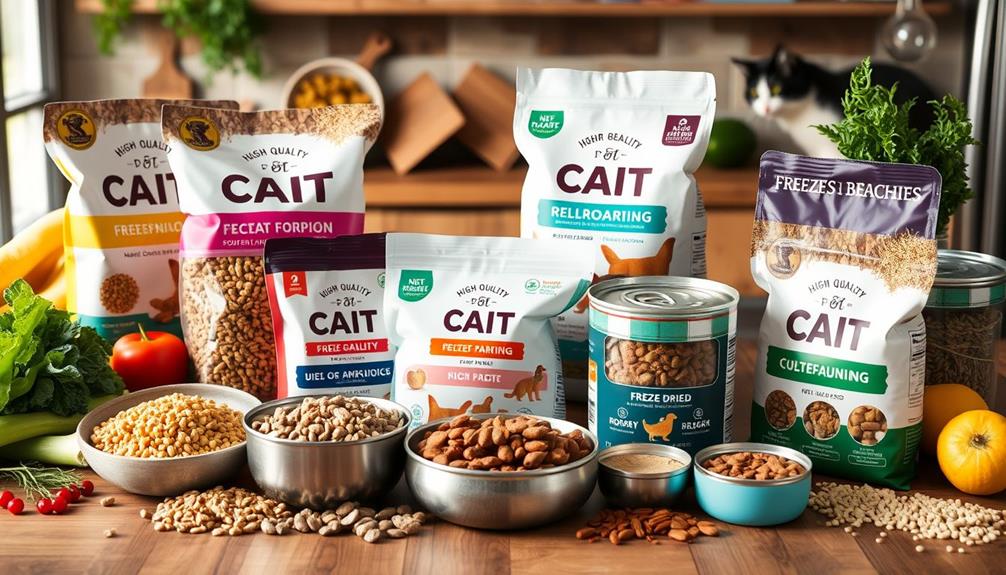
When considering alternatives to raw diets, many pet owners find themselves weighing the benefits of high-quality commercial foods. These commercially prepared options, formulated by veterinary nutritionists, provide a complete and balanced diet that meets your cat's nutritional needs without the risks associated with raw feeding.
Additionally, some commercial diets are specifically designed to support urinary health, which is essential for preventing common feline health issues recommendations for usage based on symptoms.
Cooked food is another excellent choice. It can be tailored to eliminate harmful bacteria, making it a safer alternative to raw diets. High-quality canned cat foods often have higher moisture content, supporting hydration and benefiting your cat's urinary health.
If your cat has food sensitivities or allergies, you might explore limited ingredient diets (LID) or hypoallergenic commercial foods. These options provide safe alternatives without the dangers linked to raw diets.
It's vital to consult with a veterinarian when making dietary changes. They can guide you in selecting high-quality commercial diets or cooked homemade meals that align with your cat's health needs.
Frequently Asked Questions
Why Is Raw Food Bad for Cats?
Raw food diets can expose your cat to harmful bacteria and nutritional deficiencies. They often lack essential nutrients, and unprocessed bones might cause serious injuries. It's best to stick to balanced, vet-recommended diets for your cat's health.
Why Do Vets Say Raw Food Is Bad?
Oh sure, let's serve your cat raw meat like a gourmet delicacy! Vets warn against it because of bacteria, nutrient deficiencies, and potential harm to both your pet and your family. Cooked food's safer, trust them!
Do Vets Recommend a Raw Diet for Cats?
Most vets don't recommend a raw diet for cats due to health risks like bacterial contamination and nutritional imbalances. They suggest opting for high-quality commercial cat foods to guarantee your pet's health and well-being.
What Are the Dangers of Raw Food?
Raw food diets can expose your cat to harmful bacteria like Salmonella and E. coli, leading to severe illness. They might also cause nutrient deficiencies and pose choking hazards from unprocessed bones, risking your cat's health. Additionally, raw food diets can lead to potential dental issues and digestive problems for cats. In fact, some studies have linked raw food diets to an increased risk of tooth decay and gum disease in cats. Furthermore, it’s important to note that raw food and dog constipation can also be a concern, as the lack of fiber in raw diets can lead to bowel irregularities and discomfort for pets. Therefore, it’s crucial to carefully consider the potential risks before deciding to switch your cat to a raw food diet.
Conclusion
In the grand tapestry of feline nutrition, raw food might seem like a tempting thread, but it can unravel quickly with health risks and nutritional concerns. While the allure of a raw diet is strong, remember the hidden dangers lurking within pathogens that can harm your cat. By exploring safer alternatives, you can guarantee your furry friend thrives. After all, a happy cat is a healthy cat, and that's the purrfect goal for every pet owner!
With her ability to convey complex concepts in a clear and accessible manner, Belinda ensures that readers of all backgrounds can grasp the benefits and techniques of raw food. She excels at breaking down scientific information into digestible pieces, allowing readers to understand the impact of raw food on their bodies and encouraging them to make informed choices about their diet.
One of Belinda’s notable contributions to rachaelsrawfood.com is her collection of mouthwatering recipes. She delights in experimenting with various combinations of raw ingredients, exploring innovative ways to create delicious and nutritious meals. Belinda’s recipes showcase the incredible flavors and textures of raw food and emphasize its versatility, dispelling any misconception that a raw food diet is limited or monotonous.
In addition to her writing responsibilities, Belinda actively engages with the raw food community, attending workshops, seminars, and conferences to expand her knowledge and network. She enjoys connecting with like-minded individuals, exchanging ideas, and staying up to date with the latest trends and advancements in the field of raw food nutrition.
Kitchen Essentials for Raw Food Preparation
Which Raw Food Should Be Stored Above? Essential Tips
Learn the crucial hierarchy of raw food storage to prevent cross-contamination and ensure safety—discover the essential tips that could change your kitchen practices!
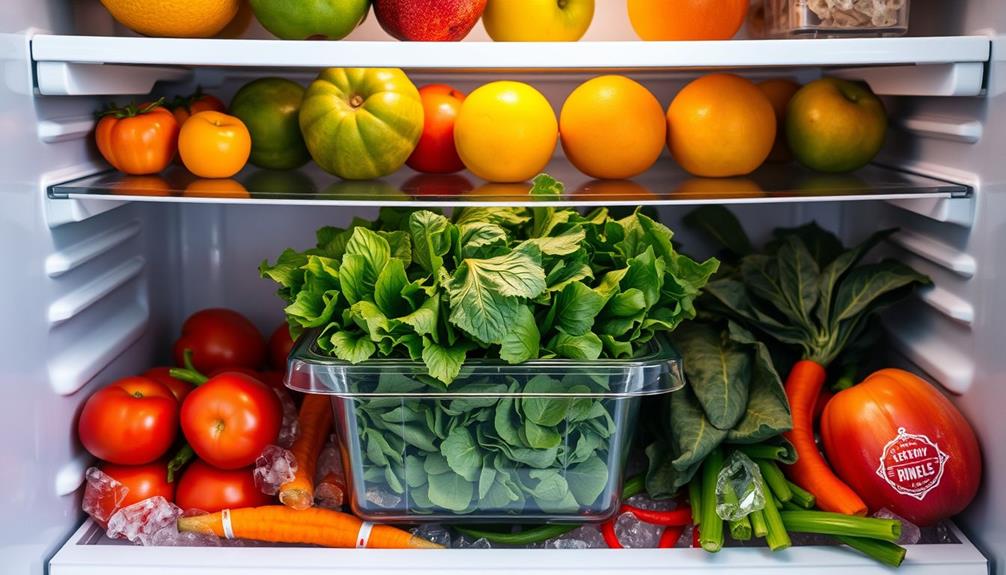
When organizing your refrigerator, always store raw fish on the top shelf. This placement minimizes the risk of cross-contamination with other foods. It's essential to wrap the fish tightly in plastic wrap or foil and keep it in a sealed container to prevent exposure to contaminants. Below the fish, you can store whole cuts of beef and pork on the middle shelf, while ground meats go lower. Finally, raw poultry should be on the bottom shelf to avoid any leakage. Understanding these storage tips can greatly enhance your food safety practices. You'll discover even more helpful advice ahead.
Key Takeaways
- Store raw fish on the top shelf to minimize the risk of cross-contamination with other foods.
- Whole cuts of beef and pork should be placed directly below fish on the middle shelf.
- Ground meats must be stored on the lower middle shelf, beneath whole cuts of beef and pork.
- Raw poultry should always be kept on the bottom shelf to prevent juices from contaminating other items.
- Use sealed containers for all raw foods to further reduce the risk of contamination.
Importance of Food Hierarchy
When it comes to food storage, understanding the importance of food hierarchy is vital for maintaining safety in your kitchen. By organizing your refrigerator correctly, you can minimize the risk of cross-contamination, which is essential for raw food safety. Proper food storage practices can help ward off foodborne illnesses, similar to how cold medications should be chosen for effective relief.
Start with seafood, which should always be stored on the top shelf. It's the most perishable and should be kept above other raw foods to prevent any juices from dripping down.
Next, place whole cuts of beef and pork on the middle shelf. This keeps them safely above ground meats and seafood, adhering to the food storage hierarchy. Ground meats and fish should be stored on the lower middle shelf, where they can be contained separately from poultry, which you must always put on the bottom shelf. This prevents any juices from raw poultry from contaminating other foods, markedly reducing cross-contamination risks.
Following this organization not only minimizes the chances of foodborne illnesses but also makes it easier to access your ingredients when cooking. By adhering to these guidelines, you guarantee that your kitchen remains safe and efficient while handling raw foods.
Storing Fish Correctly

When storing fish, it's vital to prioritize proper storage techniques to keep it fresh and safe.
You should always maintain the right temperature and take steps to prevent cross-contamination, especially with other raw foods.
Regular cleaning of storage areas is essential to guarantee hygiene and minimize the risk of foodborne illnesses.
Importance of Proper Storage
Storing fish correctly is essential for maintaining its freshness and guaranteeing food safety. To prevent contamination, always place fish on the top shelf of your refrigerator. This helps minimize the risk of juices leaking from raw meats or poultry stored below, which could spoil your fish.
Additionally, consider incorporating aquatic exercise into your routine, as it promotes overall health which is beneficial when handling and preparing food. Wrapping your fish tightly in plastic wrap or aluminum foil is important, as it prevents exposure to contaminants and helps maintain its quality.
Be certain to store fish in a sealed container, keeping it separate from raw meats and poultry. This extra layer of protection further reduces the risk of cross-contamination.
Regularly check the use-by dates on your fish to verify you're consuming it while it's still safe. Proper refrigeration is essential; keep your fish at or below 5 °C to inhibit harmful bacteria growth.
Temperature Control Guidelines
Maintaining the right temperature is essential for guaranteeing your fish stays fresh and safe to eat. Store your fish on the top shelf of the fridge to avoid cross-contamination with other raw foods like beef and pork. The ideal storage temperature for fish is below 5 °C, which helps minimize bacterial growth and keeps it fresh.
Here's a quick overview of proper fish storage:
| Storage Guidelines | Details |
|---|---|
| Ideal Temperature | Below 5 °C |
| Storage Location | Top shelf of the fridge |
| Wrap | Tightly in plastic wrap or aluminum foil |
| Below Fish | Whole cuts of beef and pork |
Always check the temperature of your fridge regularly to guarantee it stays at or below that critical level. Wrapping your fish tightly prevents exposure to contaminants, further maintaining its quality. Following these temperature control guidelines will help keep your fish safe and delicious for you and your family.
Cross-Contamination Prevention Strategies
To keep your fish safe from cross-contamination, always place it on the top shelf of your refrigerator. This prevents fish juices from dripping onto other raw foods, reducing the risk of spoilage and bacteria spreading.
Proper food handling and storage practices are fundamental to maintaining a safe kitchen environment, especially when it comes to preventing cross-contact with other raw ingredients.
Here are three fundamental strategies for storing fish correctly:
- Use a Sealed Container: Store your fish in a well-sealed container or tightly wrapped to minimize any leakage. This is critical in preventing cross-contamination with other foods.
- Separate Storage: Always keep fish separate from raw poultry and meats. These should be placed on the lower shelves to avoid any drips that could contaminate the fish.
- Monitor Temperature: Verify your refrigerator maintains a temperature of 5 °C or below. This is essential for temperature management and helps inhibit bacterial growth, keeping your fish fresh longer.
Regularly check your fish for signs of spoilage and consume or cook it within a safe timeframe.
Poultry Safety Practices
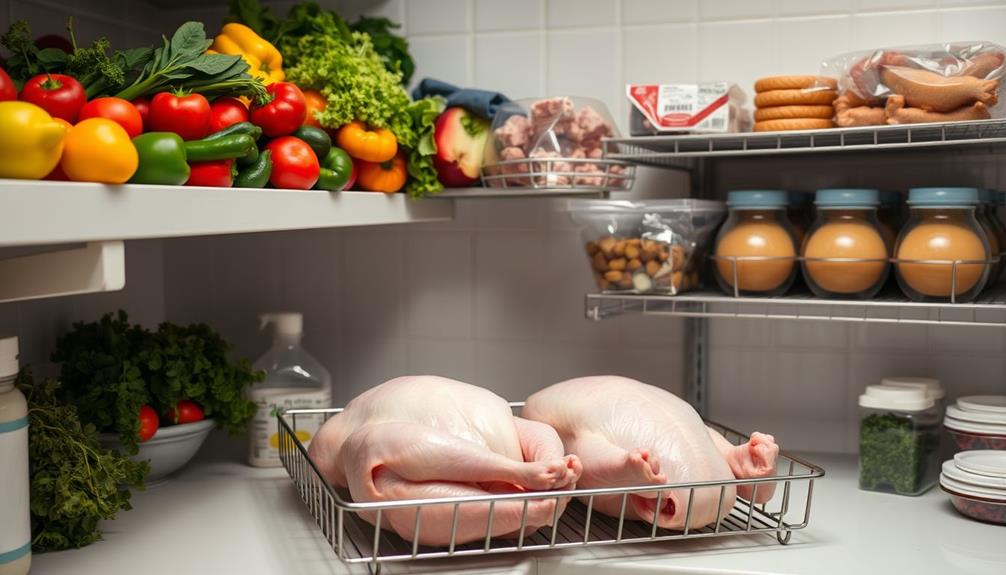
When it comes to poultry safety, proper storage is key to preventing foodborne illnesses. Always store raw poultry on the bottom shelf of your fridge to avoid cross-contamination, and make sure it's in a sealed container.
Additionally, understanding the importance of budgeting for food expenses can help you manage your grocery costs effectively.
Keeping poultry at safe cooking temperatures is just as important—let's explore how to do this effectively.
Proper Storage Hierarchy
Properly organizing your refrigerator is vital for poultry safety and overall food hygiene. Establishing a clear storage hierarchy helps prevent cross-contamination and guarantees your food stays safe.
For instance, keeping your raw meats properly stored can greatly reduce the risk of foodborne illnesses, as noted in hamster care and costs regarding proper food handling.
Here's how you can organize your raw foods effectively:
- Top Shelf: Store whole fish here. Keeping it above all other raw foods minimizes cross-contamination risks.
- Middle Shelf: Place whole cuts of beef and pork on this level, guaranteeing they're below fish but above ground meats. This organization helps maintain proper cooking temperature guidelines.
- Bottom Shelf: Raw poultry belongs here to prevent its juices from dripping onto other foods, especially ready-to-eat items located above.
Always wrap your raw foods securely in plastic wrap or aluminum foil to prevent leakage and contamination within the fridge.
By following this structured organization, you greatly reduce the chances of harmful bacteria spreading among your food.
Avoid Cross-Contamination Techniques
Cross-contamination is a serious concern in the kitchen, especially with raw poultry. To guarantee food safety, always store raw poultry on the bottom shelf of your refrigerator. This prevents its juices from dripping onto other foods, which can lead to harmful bacteria spreading. Use a sealed container or plastic bag to minimize any risk of leakage.
Early detection of foodborne illnesses can be vital, much like the importance of mammography for early detection in breast cancer.
It's essential to follow the food hierarchy; store raw poultry above raw meats and seafood. This simple step can considerably reduce the risk of cross-contamination. When preparing meals, always use separate cutting boards for raw poultry and other ingredients to avoid cross-contact of pathogens like Salmonella.
Maintaining proper refrigeration temperatures is vital, too—ideally below 5 °C. This inhibits the growth of harmful bacteria that can thrive in warmer environments. Regularly check your refrigerator to guarantee it's keeping the right temperatures.
Safe Cooking Temperatures
Cooking poultry safely is vital for preventing foodborne illnesses. To guarantee you're cooking your poultry properly, always check the internal temperature with a food thermometer. The safe cooking temperature for all poultry products, including whole birds and ground poultry, is 165°F (74°C).
It's essential to maintain a clean cooking environment and utilize proper food storage practices for peak safety, especially if you have pets that might introduce allergens into your home, as best vacuums for dust removal in 2024 can help eliminate any lingering particles.
Here are some key tips to follow:
- Store Raw Poultry: Always keep raw poultry on the bottom shelf of your fridge to prevent juices dripping onto other foods and causing cross-contamination.
- Thawing Methods: Thaw frozen poultry safely in the refrigerator, in cold water, or in the microwave. Avoid thawing at room temperature to minimize bacterial growth.
- Leftover Cooked Poultry: Refrigerate any leftover cooked poultry within two hours of cooking. Consume it within 3-4 days for peak food safety.
Managing Raw Meat Storage
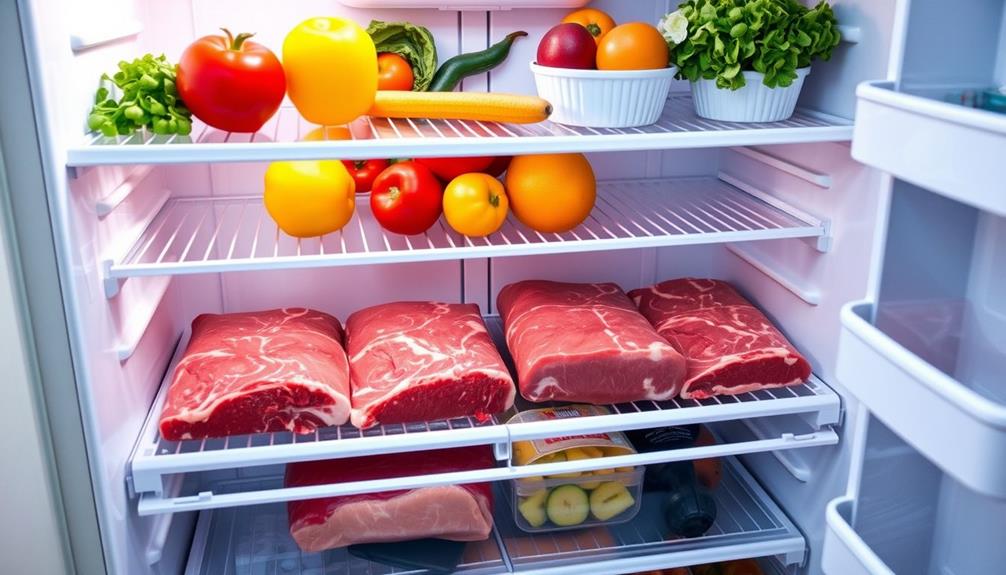
When it comes to managing raw meat storage, organization is key to ensuring food safety.
Start by storing fish on the top shelf of your refrigerator. This placement minimizes the risk of contamination with other raw foods.
It's also important to maintain a clean refrigerator environment to prevent any airborne bacteria from settling on surfaces, much like the air purifier maintenance dos and don'ts.
Below the fish, place whole cuts of beef and pork on the middle shelf. This arrangement prevents any drips that could potentially contaminate lower shelves.
Ground meats, including beef and pork, should occupy a lower shelf to reduce the risk of bacterial spread from their juices.
Preventing Cross-Contamination
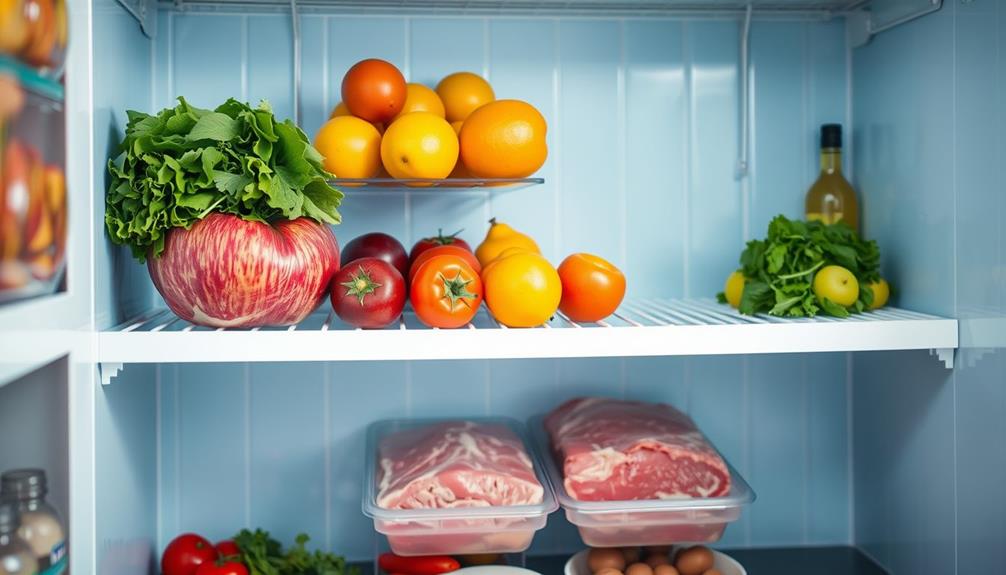
Maintaining a safe food environment means taking steps to prevent cross-contamination in your kitchen. To keep harmful bacteria at bay, you need to store raw foods correctly and guarantee that they're separate from cooked foods. Here are some essential tips to help you achieve that:
1. Store Raw Foods in Order: Always place fish at the top, followed by whole cuts of beef or pork, ground meats, and finally poultry at the bottom. This arrangement minimizes the risk of drips and leakage contaminating other items. Additionally, it’s important to store raw foods in sealed containers or leak-proof bags to further prevent cross-contamination. When storing raw foods in the refrigerator, always keep them separate from ready-to-eat items, and use different cutting boards and utensils for preparing raw meats and other foods. Following these raw food storage tips can help reduce the risk of foodborne illness and keep your kitchen safe.
Additionally, just as proper maintenance is vital for heat pumps to function effectively, maintaining proper food storage practices is fundamental for food safety.
2. Use Sealed Containers: Keep raw foods in sealed containers or plastic bags. This greatly reduces the chances of leakage, which can spread harmful bacteria and lead to foodborne illnesses.
Using sealed containers is similar to how energy-saving features in heat pumps help minimize inefficiencies and enhance performance.
3. Organize Food Storage: Regularly check and organize your food storage. Confirm that cooked foods are always stored above raw items to maintain that vital separation.
Food Safety Guidelines
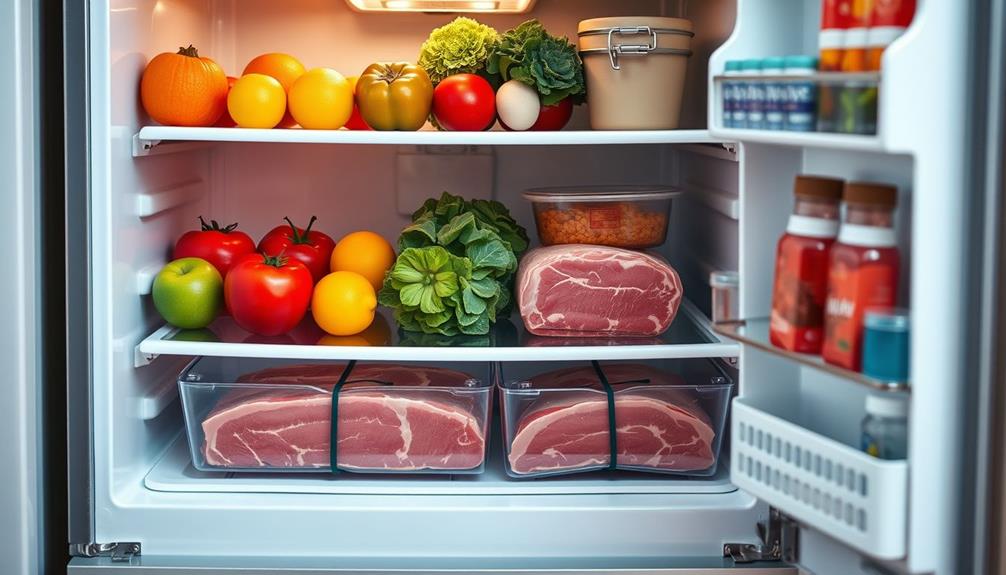
Food safety guidelines are essential for guaranteeing that your raw ingredients remain safe to eat and won't lead to foodborne illnesses. To maintain a safe storage hierarchy, place raw fish at the top of your refrigerator. This minimizes the risk of cross-contamination from its juices.
Additionally, understanding the importance of proper food handling can greatly reduce health risks associated with foodborne pathogens, similar to the ways caregivers manage financial considerations for elderly care to guarantee safety and well-being.
Below the fish, store whole cuts of beef and pork, which are less likely to harbor harmful bacteria compared to ground meats. Ground meats, like ground beef and pork, should be stored beneath whole cuts to prevent bacterial spread.
Finally, keep raw poultry—such as whole and ground chicken—on the bottom shelf, as it poses the highest risk of carrying pathogens like salmonella.
Always wrap your raw foods securely in aluminum foil or plastic wrap. This prevents exposure to contaminants and avoids any leakage that could affect other foods in your fridge.
Best Storage Containers
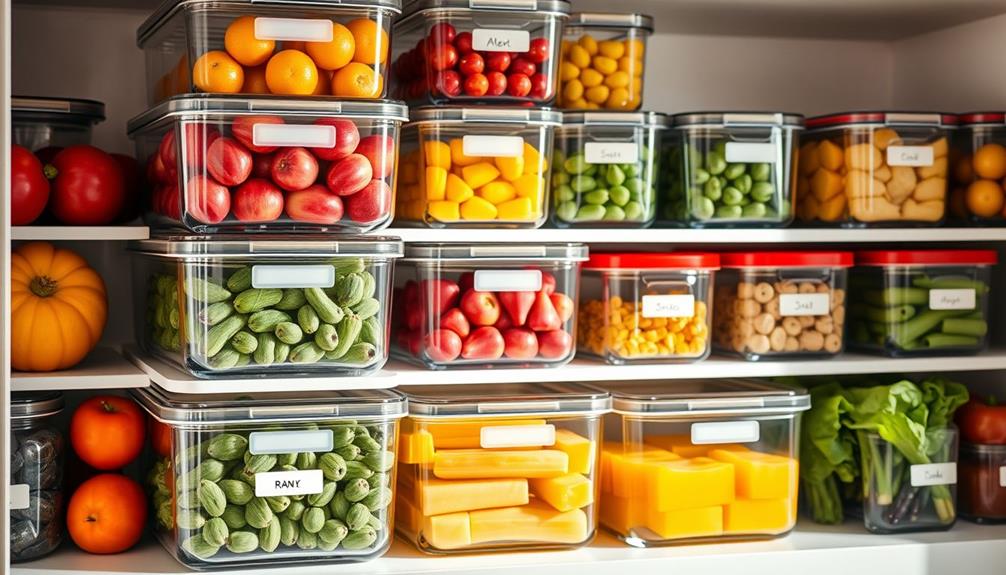
Choosing the right storage containers can make a big difference in keeping your raw foods safe and fresh. To effectively prevent cross-contamination and maintain the quality of your ingredients, consider these tips:
- Use airtight containers: Opt for glass or BPA-free plastic containers with tight-fitting lids. They not only prevent leaks but also keep odors from mingling and help maintain freshness.
- Label everything: Clearly label your storage containers with the contents and date of storage. This practice guarantees you track use-by dates and minimizes the risk of using spoiled food.
- Create visual distinction: Utilize separate colored containers for different food groups like raw meat, poultry, and seafood. This method aids in easily identifying contents and greatly reduces cross-contamination risks.
For freezer use, choose thicker food storage bags designed for that purpose. They're less likely to puncture or leak, guaranteeing your raw foods stay safe.
Frequently Asked Questions
Which Raw Food Should Be Stored Above?
When storing raw foods, you should place whole fish on the top shelf. This helps reduce cross-contamination risks. Remember to wrap them securely to prevent any leaks that could affect other items below.
Which Food Should Be Stored Above?
Imagine the chaos of a kitchen gone wrong. You should store fish on the top shelf to prevent cross-contamination. It's essential for maintaining safety, ensuring your meals are delicious and free from any harmful bacteria.
Which Food Should Be Stored Above Others in the Refrigerator?
When storing food in your refrigerator, always place fish on the top shelf. It minimizes cross-contamination risks. Below that, keep whole cuts of beef and pork, followed by ground meats and poultry on the bottom.
What Is the Proper Way of Storing Raw Food?
Imagine your fridge as a well-organized library. When storing raw food, wrap it tightly, use sealed containers, and arrange by type. This keeps everything fresh and prevents contamination, just like protecting valuable books from damage.
Conclusion
By understanding the importance of food hierarchy and proper storage techniques, you can keep your kitchen safe and your meals delicious. Just like stacking building blocks, each layer of food needs to be placed thoughtfully to prevent disaster. Remember to store fish above poultry, and always keep raw meat at the bottom. With these tips, you'll guarantee freshness while protecting your loved ones from cross-contamination. Your kitchen can be a safe haven for healthy eating!
Rachael, the Editor in Chief of RachaelsRawFood.com, is an inspiring and passionate individual who has dedicated her life to promoting the benefits of a raw food lifestyle. Known for her vibrant and energetic personality, Rachael has built a strong online presence that has transformed her personal journey into a thriving community of raw food enthusiasts.
-

 Health and Wellness2 months ago
Health and Wellness2 months agoDoes Eating Raw Food Help You Lose Weight? Discover the Truth
-

 Raw Food Recipes2 months ago
Raw Food Recipes2 months agoHow Much Raw Food to Feed Your Puppy: Essential Tips
-

 Kitchen Essentials for Raw Food Preparation1 month ago
Kitchen Essentials for Raw Food Preparation1 month agoCan You Cook Raw Food in an Air Fryer? Discover the Possibilities
-

 Raw Food Recipes2 months ago
Raw Food Recipes2 months agoHow to Defrost Dog Raw Food Properly
-

 Health and Wellness2 months ago
Health and Wellness2 months agoHow Long Does It Take Bacteria to Spread From Raw Food? Essential Info
-
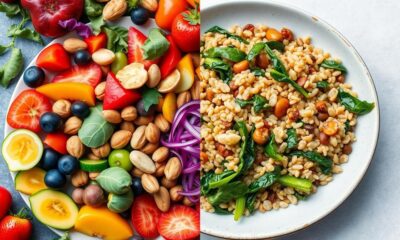
 Raw Food Recipes2 months ago
Raw Food Recipes2 months agoRaw Food Vs. Vegan: Which Diet Is Better?
-

 Raw Food Recipes2 months ago
Raw Food Recipes2 months agoIs Raw Food Good for Cats? Find Out Here
-
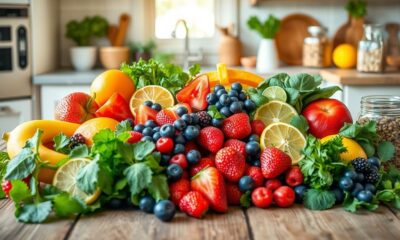
 Raw Food Recipes2 months ago
Raw Food Recipes2 months agoWhat Is the Raw Food Diet? A Comprehensive Overview


